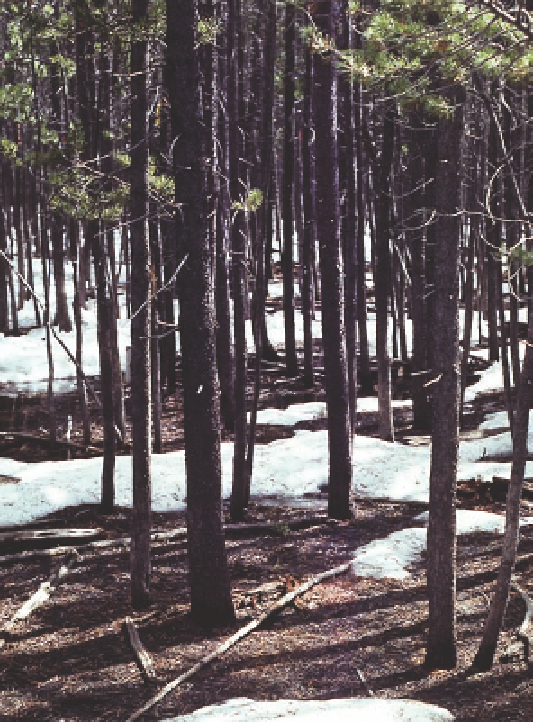Geoscience Reference
In-Depth Information
to as
doghair stands
(fig. 11.16). the growth of individual
trees is slow in such places, but most survive and con-
tinue to produce seed for well beyond a century, though
remaining less than 4 inches in diameter. not all lodge-
pole pine stands are so dense, however, as densities vary
greatly across the landscape. Historical reconstructions
in Yellowstone national Park revealed that, over time
spans of about 200 years, varying densities converge on
ferent densities become more similar over time because
of self-thinning of initially dense stands and gradual
infilling of initially sparse stands (that is, by the estab-
lishment of young trees in older stands). other distur-
bances affecting landscape patterns in lodgepole forests
include comandra blister rust, dwarf mistletoe, bark
beetles, root rot, and windstorms.
the effects of twentieth-century fire exclusion are
not nearly as significant in lodgepole pine forests as
in ponderosa pine and Douglas-fir forests, primar-
ily because fires were infrequent and typically of
high severity in lodgepole pine forests even before
euroAmericans ushered in fire suppression efforts.
Also, the fire regime is controlled more by weather and
climate than by ignition sources or variation in fuel
been suppressed in the lodgepole pine zone, and that
some fires ignited in lower-elevation forests might
have burned up into the lodgepole had they not been
suppressed at the source. However, in most years such
fires would have been small, because the fuels at the
high elevations occupied by lodgepole pine histori-
cally were too wet for extensive fires. in dry years when
the weather is conducive to fire, the normal fuel struc-
ture in lodgepole pine forests allows fires to spread
quickly and they are not readily suppressed. Had there
been no fire suppression during the twentieth century,
young lodgepole pine stands would be somewhat more
abundant today and old stands somewhat less so—but
today's distribution of stand ages does not differ greatly
from what would have been seen in previous centuries.
Moreover, recent large fires in lodgepole pine forests
have created extensive stands of young forests (see
chapter 15). As discussed in the next chapter, climate
change could increase the frequency and intensity of
fires if the summers become drier, as predicted because
Fig. 11.16. the trees in this dense stand of lodgepole pine
are small but are about 100 years old—probably because the
previous forest that burned had a large number of trees with
serotinous cones. Also, the fire was not intense enough to
burn the cones and their seed, and the climatic conditions
after the fire were ideal for seedling establishment. With
about 6,000 trees per acre, there are few understory plants.
Unlike the dense ponderosa pine forest shown in fig. 11.8,
lodgepole pine forests such as this one are not caused by fire
suppression. Photo taken southwest of Dry Park in the Medi-
cine Bow Mountains. elevation 9,160 feet.
Spruce-Fir Forest
engelmann spruce and subalpine fir often dominate
forests at higher elevations and in cool ravines, most
likely because their seedlings tolerate the lower temper-
atures and because more water is available longer into
have lower water-use efficiencies than lodgepole, which
means that they require larger amounts of water for
every gram of new plant material they produce. conse-
quently, the pine survives on drier sites at lower eleva-
tions, where water stress is likely to develop. Ponderosa

Search WWH ::

Custom Search